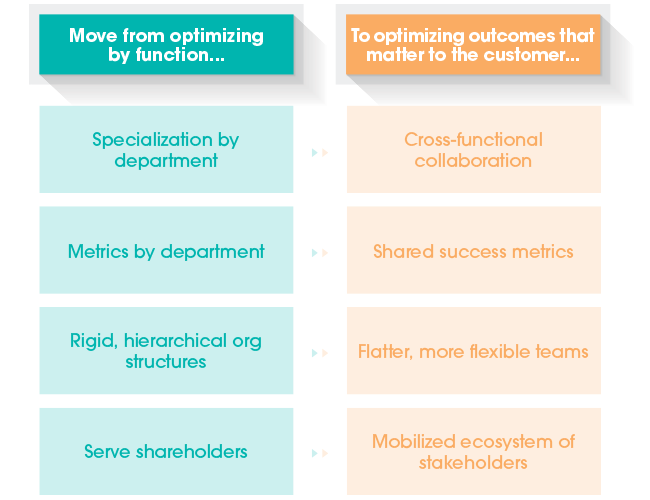This post is part of a regular series called 360 Perspectives, featuring customers, partners, and experts unraveling the complexities of what it takes to change mindsets, connect silos, and put the customer at the center of their business.
Who owns customer centricity? Ultimately, everyone in your organization does. That means collaboration must be your top priority.
In a previous article from this series, we talked about the need for customer-centric business processes, which lie at the heart of any customer-focused business. How do you bring these processes to life? You have to act as a unified team across silos so employees closest to the end customer are empowered to create enduring relationships.
Customer-centric companies have silos, too. They have clear designations of who’s doing what for efficiency. But they empower distinct departments to share, collaborate, and deliver integrated customer experiences — down to even the most junior employees.
Empower every employee to deliver the full force of the company
There is a good reason for silos: speed and efficiency. In the past, you could leave that statement and move on, confident in its accuracy. In today’s — and tomorrow’s — digital world, rigid silos might be fast and efficient at repetition, but they are slow, expensive, and critical of change. To move your company from product-centric to customer-centric, you can keep silos but you have to advance them with new tools, new language, and new culture to ensure they become flexible, hyper-collaborative, and sensitive to customer needs.
What happens when customers have a poor experience with your brand? They speak to the first person they get from the company, and they don’t care what department the person is in. Unfortunately, and all too often, the customer ends up having to navigate the org chart to get what they want. Employees are simply not empowered and connected to serve the customer’s needs.
This requires us to abandon the top-down organizational structures we’ve inherited from the early 20th century, with rigid divisions between sales, service, marketing, and IT. And in a world where your customer is at the center of your organization, what the highest-paid person in an organization wants may not be as important as what the customer wants.
It’s time for flexible, flatter, and empowered team structures.

Customer-centric companies think carefully about the customer experience and develop a customer-first culture to improve it. They overlay this culture with the tools and information everyone needs to make it easy to collaborate across teams and departments in the service of the customer. These same companies cultivate information transparency and celebrate team behavior.
Thousands of our customers are born digital and customer-first. For them, the challenge is one of formalizing the culture and collaboration tools as they scale. For thousands of larger companies, the issues are slightly different. They see immediate results, especially around NPS and CSAT scores when they formalize multidisciplinary teams dedicated to a location. This case study on T-Mobile shows how bringing together cross-functional teams delivers improved revenue, NPS scores, and customer retention.
Make a plan with internal stakeholders to get started
To start to make this discipline a reality, review your goals and KPIs with peers or departmental leaders outside your team — even those that don’t normally work together. Explore how you can help each other, and find goals you can share. Celebrate successes as a broader team as you step away from partitioned, traditional responsibilities.
Review the following list. How can you move from the department-specific approaches on the left to the customer-first set on the right? Have you listened to all perspectives, especially from those who are on the front lines with customers every day? Who is responsible for designing the end-to-end customer experience and where are the internal bottlenecks?

To become a customer company, you must have the mindset to evolve your business model, culture, and organization. Technology is only an enabling platform for change. The real transformation takes place when everyone within the organization shares the commitment to place the customer at the center of everything.
For more information, check out the customer 360 playbook or read thisstory on how the CTO of Edelman Financial Engines evolved his department from functional product teams to “customer journey” teams.





























